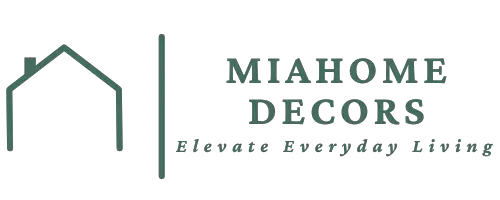Effortless Curb Appeal: Low-Maintenance Flower Bed Ideas for the Front of Your House
Table of Contents
Introduction
According to the National Association of Realtors, 94% of real estate professionals say curb appeal improves a home’s marketability—and flower beds are often the first thing people notice. But not everyone has the time, energy, or green thumb to manage high-maintenance landscaping.
The good news? You can have a beautiful, blooming front yard without dedicating every weekend to weeding, watering, or pruning.
Low-maintenance flower beds are all about smart plant choices, practical layout planning, and minimal intervention. Whether you’re a busy homeowner, new to gardening, or simply prefer a tidy look with little effort, these ideas will help transform your front yard into a welcoming, floral-forward space that practically takes care of itself.
In this post, we’ll explore a variety of easy-care perennials, layout strategies, mulch tricks, and low-fuss design tips to help you create a flower bed that’s both beautiful and manageable. Let’s design a front yard that blooms with style—not stress.
In-Depth Outline
1. Choosing the Best Low-Maintenance Plants
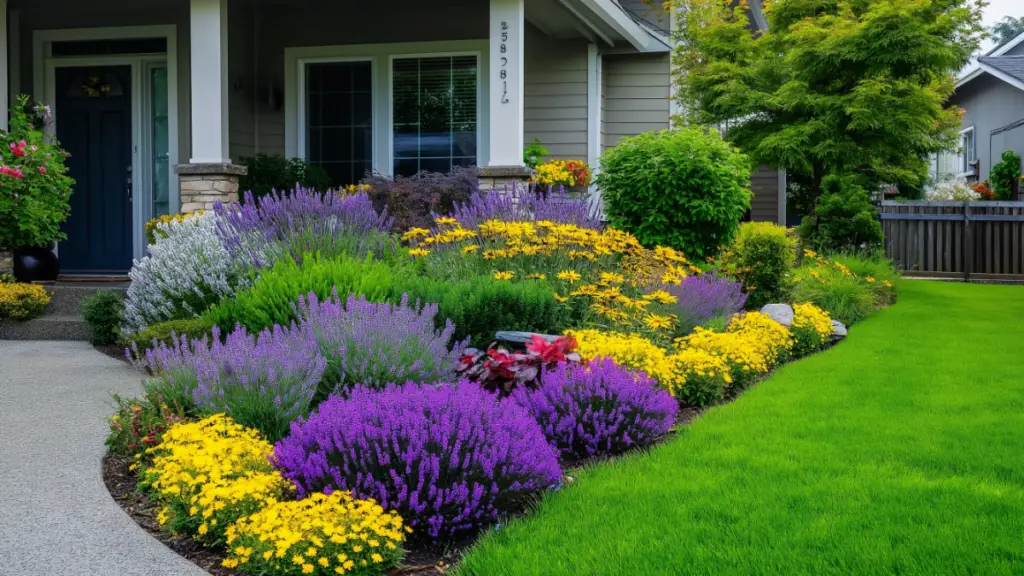
- Prioritize native plants for your region
- Drought-tolerant varieties require less watering
- Long-blooming perennials = less replanting
- Avoid invasive species and high-maintenance blooms
- Use evergreen shrubs for year-round structure
Table: Best Low-Maintenance Perennials
| Plant Name | Bloom Season | Water Needs | Maintenance Level |
|---|---|---|---|
| Black-Eyed Susan | Summer–Fall | Low | Very Low |
| Lavender | Late Spring–Summer | Low | Low |
| Salvia | Spring–Fall | Low | Low |
| Sedum (Stonecrop) | Late Summer | Very Low | Minimal |
2. Flower Bed Layouts That Practically Maintain Themselves
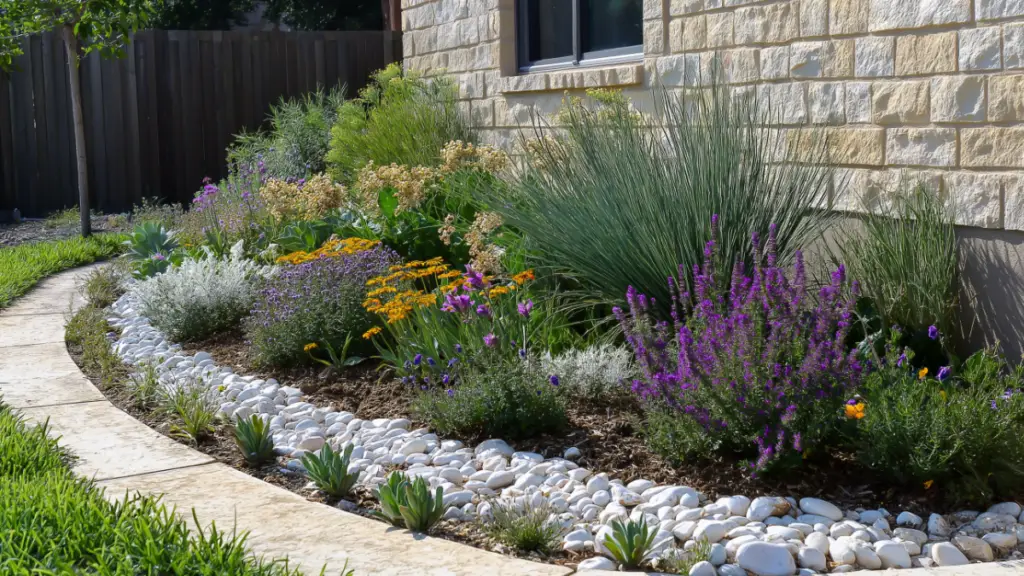
- Use curved beds for a natural, forgiving look
- Keep plant spacing generous to reduce weeding
- Layer heights: tall back, midsize center, groundcover front
- Incorporate hardscape borders for clean lines
- Minimize lawn edge trimming with stone or metal edging
Table: Sample Flower Bed Layout (3-Layer Approach)
| Layer | Plant Type Examples | Benefits |
|---|---|---|
| Back Layer | Hydrangeas, Ornamental Grasses | Visual height, wind barrier |
| Middle Layer | Salvia, Coneflower | Color and pollinator appeal |
| Front Layer | Creeping Jenny, Thyme | Fills gaps, reduces weeds |
3. The Power of Mulch: Beauty and Function
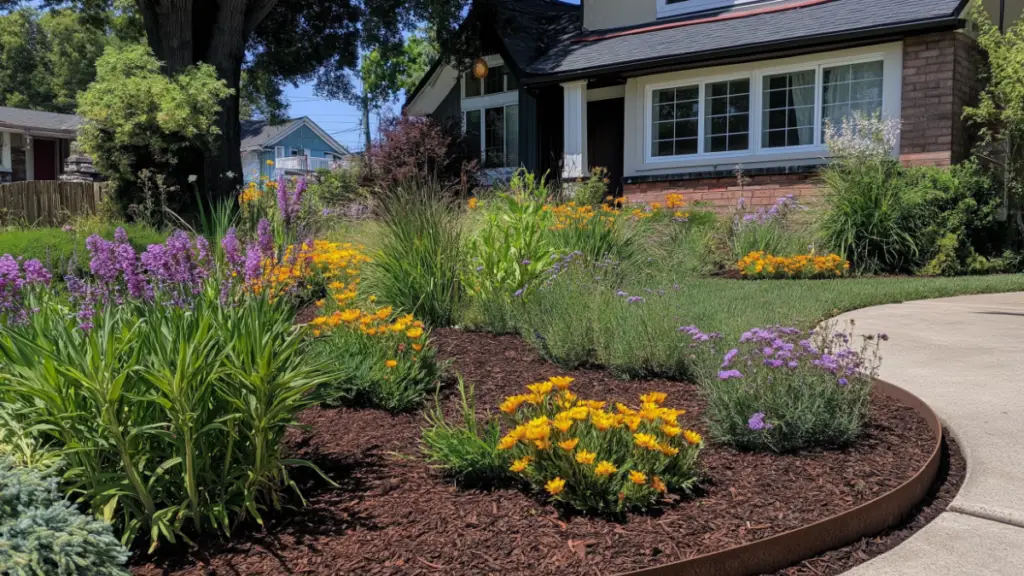
- Mulch retains moisture and reduces weeds
- Choose shredded bark, rubber, or stone mulch for aesthetics
- Apply 2–3 inches, but keep away from stems
- Replenish once a year for long-lasting results
- Use landscape fabric underneath for extra weed control
Table: Mulch Types Comparison
| Mulch Type | Aesthetic Appeal | Longevity | Maintenance Frequency |
|---|---|---|---|
| Shredded Bark | Natural/rustic | 1–2 years | Annual top-up |
| Rubber Mulch | Clean/formal | 5+ years | Minimal |
| Stone Gravel | Modern/durable | Permanent | Very Low |
4. Easy-Care Flower Color Palettes

- Monochrome beds for a cohesive look
- Use complementary color pairs for contrast
- White flowers = elegant, timeless appeal
- Cool tones create calm; warm tones add energy
- Use foliage color (silver, burgundy) to enhance interest
Table: Low-Maintenance Flower Color Schemes
| Color Scheme | Flower Examples | Mood Created |
|---|---|---|
| Cool Blues | Salvia, Russian Sage | Calm and serene |
| Warm Yellows | Coreopsis, Black-Eyed Susan | Cheerful and bright |
| Elegant Whites | Shasta Daisy, Alyssum | Clean and classic |
| Bold Burgundy | Heuchera, Daylilies | Sophisticated contrast |
5. Low-Water Landscaping Tips

- Group plants by water needs
- Install drip irrigation or soaker hoses
- Use rain barrels to water sustainably
- Replace thirsty grass with flowering groundcovers
- Add gravel paths to reduce water usage zones
Table: Water-Saving Flower Bed Strategy
| Technique | Water Saved (Est.) | Bonus Benefit |
|---|---|---|
| Drip irrigation | Up to 50% vs. hose | Targets roots only |
| Mulching | Retains 25% more | Fewer weeds, cleaner look |
| Native plants | No extra watering | Supports local wildlife |
6. Edging and Borders for Effortless Maintenance
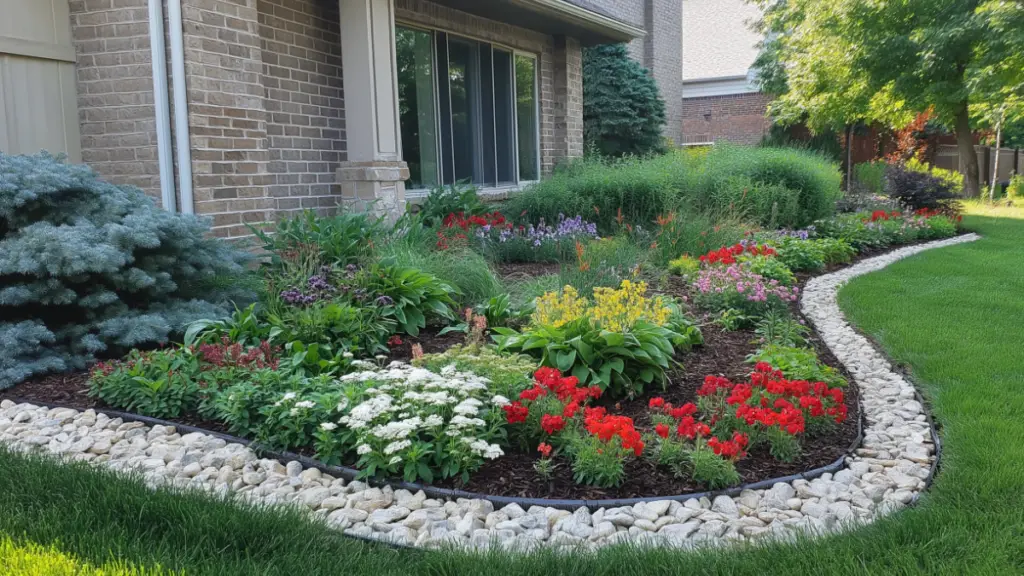
- Define flower bed shape with metal, stone, or brick borders
- Prevent grass and weeds from invading beds
- Choose materials that complement your home style
- Raised beds reduce bending and enhance drainage
- Install edging once for years of maintenance savings
Table: Border Material Options
| Material | Look | Durability | Style Match |
|---|---|---|---|
| Brick | Classic/traditional | High | Colonial, Craftsman |
| Metal (Corten) | Sleek/modern | High | Contemporary, minimalist |
| Natural Stone | Organic/rustic | Very High | Cottage, farmhouse |
7. Groundcovers That Do the Work for You
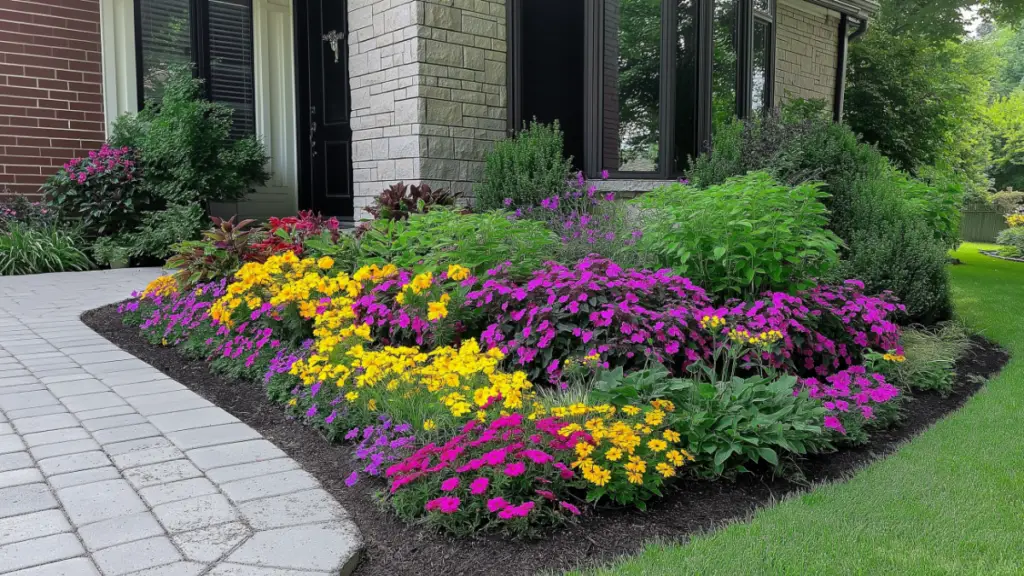
- Creeping thyme or sedum fill in gaps beautifully
- Great for slopes or tricky areas
- Suppress weeds and retain soil moisture
- Some varieties offer seasonal blooms or color changes
- Ideal for beds around walkways or driveways
Table: Top Groundcovers for Flower Beds
| Plant Name | Flowering? | Sun Needs | Foot Traffic Tolerance |
|---|---|---|---|
| Creeping Thyme | Yes | Full Sun | Moderate |
| Blue Star Creeper | Yes | Partial | High |
| Sedum ‘Dragon’s Blood’ | Yes | Full Sun | Low |
| Sweet Woodruff | Yes | Shade | Low |
Detailed Content Expansion
1. Choosing the Best Low-Maintenance Plants
The foundation of a low-maintenance flower bed starts with choosing the right plants. Native perennials are your best friend—adapted to local climates, they thrive with minimal intervention. For most zones, Black-Eyed Susans, Lavender, Coneflowers, and Sedum top the list for fuss-free, beautiful blooms.
Drought-tolerant plants are essential, especially for busy homeowners or water-restricted areas. Lavender not only needs little watering but also offers a delightful fragrance and pest-repelling properties. Sedum (also known as stonecrop) stores water in its thick leaves, making it a resilient option for sunny spots.
Perennials that reliably return each year mean less time spent replanting or replacing dead annuals. You’ll also want plants that require minimal deadheading (removal of spent blooms), saving you valuable weekend time.
Table: Best Low-Maintenance Perennials
| Plant Name | Bloom Season | Water Needs | Maintenance Level |
|---|---|---|---|
| Black-Eyed Susan | Summer–Fall | Low | Very Low |
| Lavender | Spring–Summer | Low | Low |
| Coneflower | Summer–Fall | Low | Low |
| Sedum | Late Summer | Very Low | Minimal |
Choose a few plants that offer a variety of textures and heights to add visual interest. With smart choices, your flower beds can look polished all season long—with very little work on your part.
3. The Power of Mulch: Beauty and Function
Mulch is one of the most effective tools in a low-maintenance gardener’s arsenal. It serves both an aesthetic and functional purpose—adding rich color and texture to your beds while conserving moisture and suppressing weeds.
Natural options like shredded bark mulch give a rustic, earthy appeal and break down over time, enriching your soil. Rubber mulch, made from recycled materials, offers a more modern look and lasts for years without fading. Stone or gravel mulch is perfect for drought-prone areas and lends a clean, architectural vibe.
Apply mulch 2–3 inches deep, being careful not to pile it directly against plant stems. This layer acts like a natural blanket—keeping soil cool, retaining water, and deterring weed growth. Refresh bark mulch yearly to keep your beds looking vibrant.
Table: Mulch Types Comparison
| Mulch Type | Aesthetic Appeal | Longevity | Maintenance Frequency |
|---|---|---|---|
| Shredded Bark | Natural/rustic | 1–2 years | Annual top-up |
| Rubber Mulch | Clean/formal | 5+ years | Minimal |
| Stone Gravel | Modern/durable | Permanent | Very Low |
Mulch makes your garden look finished—and saves hours of future weeding and watering.
Conclusion
Creating a stunning front yard doesn’t require constant upkeep. With the right plant choices, smart layout strategies, and a few design-savvy tricks like mulch and groundcovers, you can enjoy a colorful, welcoming flower bed that essentially takes care of itself. Low-maintenance landscaping isn’t about doing less—it’s about doing it smarter. Whether your aesthetic leans rustic, modern, or traditional, there’s a low-maintenance solution that will elevate your curb appeal while freeing up your weekends.
